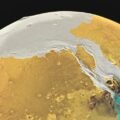New research involving Charles Darwin’s theories on the origin of life on Earth provides fresh support for the idea that life could have emerged from lakes and ponds high in phosphates. Performed by researchers from the University Of Washington (UW), the study may also make a compelling case for finding life on other planets where they believe similar lakes are likely to exist.
“This study adds to growing evidence that evaporative soda lakes are environments meeting the requirements for origin-of-life chemistry by accumulating key ingredients at high concentrations,” said senior author David Catling, a UW professor of Earth and space sciences.
Ever since Darwin’s 19th-century work on the origin of life on Earth, scientists have debated various ideas about how life may have first evolved. Some theories postulate that life came from outside Earth and was seeded here by comets and meteors. In recent years, this idea has gained some support as researchers have discovered amino acids and other building blocks of life on objects that originated outside Earth.
Still, most scientists favor Darwin’s “warm little pond” proposal, although efforts to recreate the conditions in a lab have fallen short of creating new life from organic matter. Now, a UW research team says their work found evidence that Darwin may have been right after all, potentially answering the question of the origin of life once and for all.
Soda Lakes High in Phosphates Seem Just Right for Origin of Life on Earth
Early efforts to understand how life first emerged were able to create amino acids from lifeless matter, essentially marking the first step from a lifeless Earth to one teeming with life. More recently, researchers were able to coax these amino acids into forming the building blocks of RNA, which is essentially the backbone of DNA and all life.
The trick, the researchers explain, was finding a watery environment that contained the extremely high concentration levels of phosphates needed to make the amino acid-RNA transition. That means phosphate levels that are hundreds to millions of times higher than found in everyday lakes and rivers.
Luckily, the team was able to find just such a place in Canada that is populated with high-phosphate bodies of water known as “soda lakes.” According to the study’s authors, such lakes were likely common on early Earth.


“I think these soda lakes provide an answer to the phosphate problem,” Catling said. “Our answer is hopeful: This environment should occur on the early Earth, and probably on other planets, because it’s just a natural outcome of the way that planetary surfaces are made and how water chemistry works.”
These ideas are supported by previous work from the UW team that was able to show how these soda lakes could successfully concentrate phosphates at levels reaching up to 1 million times higher than regular bodies of water.
How Dry Wind and Volcanic Rock Concentrate Phosphates
Published in the journal Communications Earth & Environment, the researchers detail their analysis of Last Chance Lake in inland British Columbia, which contains these soda lakes. Specifically, the lake rests on top of volcanic basalt rock and is constantly exposed to dry winds that evaporate the water off of the surface. This process leaves behind the phosphates, thereby slowly but surely increasing their concentrations over time.
The result is a “soda” lake with just the right amount of water and phosphate concentrations the researchers and Charles Darwin himself suspect were present on Earth over 4 million years ago. The researchers also theorize that due to natural processes at work in Last Chance Lake, these types of lakes could have been present on early Mars and early Venus.
“We studied a natural environment that should be common throughout the solar system,” said lead author Sebastian Haas, a UW postdoctoral researcher in Earth and space sciences. “Volcanic rocks are prevalent on the surfaces of planets, so this same water chemistry could have occurred not just on early Earth, but also on early Mars and early Venus if liquid water was present.”
Origin of Life Research Could Aid Search for Habitable Environments on Other Planets
Although the research team did not try to create life in a lab like some previous experiments, they believe their research lends strong support that early Earth may have contained bodies of water that contained high concentrations of phosphates and that these lakes were perfectly suited to birth the first living organisms.
“This study adds to growing evidence that evaporative soda lakes are environments meeting the requirements for origin-of-life chemistry by accumulating key ingredients at high concentrations,” Catling said.
Moving forward, the team says that they believe their research may not only answer the questions of life’s origins here on Earth but may also help researchers replicate these findings in a lab setting. They also posit that their findings could help astrobiologists narrow their list of targets when hunting for life outside of Earth, which is another of science’s unsolved mysteries.
“These new findings will help inform origin-of-life researchers who are either replicating these reactions in the lab or are looking for potentially habitable environments on other planets,” Catling said.
Christopher Plain is a Science Fiction and Fantasy novelist and Head Science Writer at The Debrief. Follow and connect with him on X, learn about his books at plainfiction.com, or email him directly at christopher@thedebrief.org.

